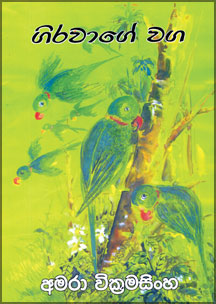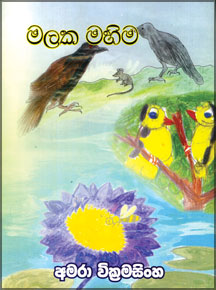Parrots and flowers for children
 Writing creative works may look easy on the surface, but I presume it
needs careful scrutiny on the part of the creator as well as the
recipient. Writing creative works may look easy on the surface, but I presume it
needs careful scrutiny on the part of the creator as well as the
recipient.
For some Sinhala writers, the production of flimsy books in the name
of children’s literature is a lucrative business. But we also encounter
the alternative attention and dedication to a worthy function of
moulding a sensitive genre which is guided by an academic vision and
mission.

Such a writer I felt is Amara Wickramasinghe whose two new Sinhala
works are written on two main aspects of nature as creative guidance to
children titled as Giravage Vaga (Story of the Parrot) and Malaka Mahima
(Worth of a Flower). Both books are author publications illustrated by
art teacher Virgnia Wickramainghe.
In the first instance the creative spirit in the writer Amara
Wickramaisnghe has to be felt on two layers. First she delves on various
cultural nuances woven around the subject. Then she weaves a narrative
to present the material.
In the story of parrots, Wickramasinghe sees the parrot as a bird
which had had multifarious ways of living in the distant past. The
character of the parrot is found as linked into the life of Bodhisatva
as found in the Jataka tales. The story of parrot as a legendary bird is
retold in this manner.
At the same time the scientific factors such as links that lay
between humans and parrots too are brought out as meaningful
observation, which may help kindle the interest in the ways of birds
around the life of a child. The role of the parrot in our day to day
life is renarrated as an amusing series of tales that link the past and
the present evolutionary areas.
The parrot that fell into the group of robbers imitated them, and the
parrot that fell into the group of sages became meditative. This age old
parable of the Buddha is made to be a visionary tale in more modern
terms. I felt that this piece of narrative is a fine gift to children of
all ages.
On reading the other book, I found that a similar type of creative
method is utilized. Amara selects the flower known as lotus which has
various meanings. The flowers known as Olu, Nelum and Manel are all
known by the common title Piyum.
The flower, which is pleasing to any type of person living in the
Orient, is also regarded as a venerated flower as it is carefully
plucked from the lakes and ponds. Though quite a lot has been written
about Manel Mala, the creativity attached to the same is innumerable.

The author Amara in a pleasing tone of her narrative form makes use
of two characters: a brother and a sister, Utpala and Utpalaa
(attributed to the name of lotus in male and female sense). Making use
of those characters the author tries to depict the way of the lotus as
it could be observed and carefully studied step by step.
This helps children sharpen their sense of observation to know what a
flower is and how it is connected to the ways of nature. The author
invites the child reader to set about a watchful eye on the ways of
nature, and gauge for oneself the nuances it bears.
In that direction the book looks like a creative journey into the
realm of nature. With several natural disasters as caused by humans, the
time is ripe for a sensitive teacher to help the child to love the
nature more and more. These two books, I sincerely feel, are written
with good intention.
At this juncture I remember a certain article written by two Indians,
who lived in Japan, to the Hindu at the time of the great disaster
caused by the recent Tsunami. They went on unfolding some of the
man-made activities as caused by technological means to the Mother
Nature, where she was ill-treated by human hands.
As they pointed out it was the weep and the wail of the ocean which
resulted in the Tsunami. When we are angry and disturbed, we harm the
Mother Nature, so much that she weeps bitterly which in turn is a
revenge reminding not to repeat our cruel mannerisms.
So coming back to the books of Amara, I felt that creative message
given to the child reader is embraced with a wider spectrum of love and
care that nature needs. The author is sensitively selective and knows
what the child of the day needs. These two books are real gifts to our
children!
[email protected]
|



